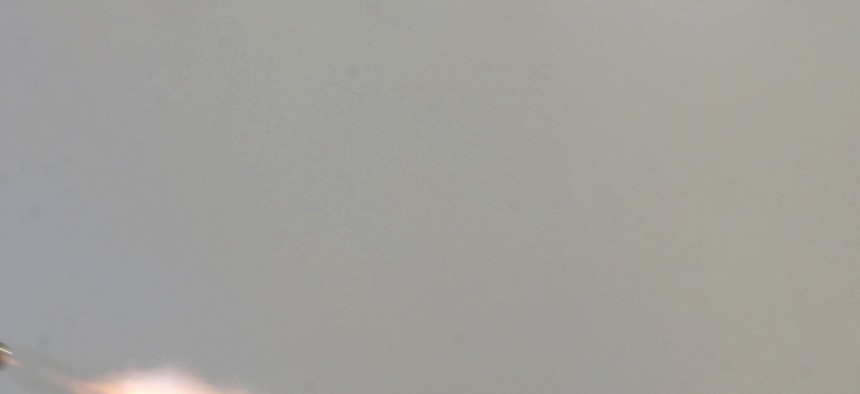
In this Sept. 3, 2014 photo, Iraqi security forces and Shiite militiamen fire at Islamic State group positions during an operation outside Amirli, some 105 miles north of Baghdad, Iraq. AP Photo
The Islamic State May Have Hit the Point of Diminishing Returns
As Iraqi security forces regain their footing, the Islamic State's use of terror is not enough to relieve the pressure they face on the battlefield. By Col. Clint Hinote
After the release of the second Islamic State in Iraq and Syria (ISIS) propaganda video Tuesday depicting the murder of U.S. reporter Steven Sotloff, I’ve examined both videos in context. When taken together, we can glean some interesting points, the most important of which is the level of desperation and frustration displayed by ISIS.
First, a personal note: My heart goes out to the families of Steve Sotloff and James Foley. As a father, I cannot imagine the horror they have endured. These videos show the sheer evil and depravity of ISIS. To kill an innocent journalist (whom they surely know has no control or influence over US policy) is contrary to any moral framework, including Islam. One of the reasons that I continue serve in the U.S. Armed Forces is that there is evil in the world, and if good people stand back and do nothing, that evil will spread.
Fortunately, several groups have taken strong action against ISIS in the last few days, including the Kurds, Shiite militia groups, and the Iraqi Army. The addition of U.S. firepower has been critical, and as we can see from these two videos, this has caused a significant level of desperation in ISIS. In short, ISIS is out of ideas on how to influence its environment. They have overreached in trying to take and hold such a large area, and their use of terror—chilling as it may be—is not enough to relieve the pressure they face on the battlefield.
It is interesting that the Telegraph is reporting that the video was released before it was actually “published”by ISIS. For those of us who have tried to coordinate communication across a large, distributed organization, this is hardly surprising. It is certainly possible that the central ISIS leadership may have been waiting to release the video until a more favorable moment, or they may have decided not to release it at all. ISIS is known for a leadership doctrine of “centralized control and decentralized execution,”and when combined with classified details about the organization, this error in execution may help the U.S. to understand the challenges within the group as they struggle to adapt to rapidly changing events on the ground.
When one puts emotion aside to analyze these two videos, it is clear that they represent the strategic dialogue as seen by ISIS. They follow a consistent pattern: President Obama speaks of taking action against ISIS, the hostage speaks a message designed to weaken President Obama’s domestic political position, then the killer speaks a message designed to look tough while making demands of the president. After committing the murder and showing off the dead bodies of the hostages, the killer points to another hostage and speaks an ominous warning.
This undoubtedly plays well to ISIS’ internal audiences as well as disaffected Muslims. Certainly, the image of the knife-wielding executioner standing up to the most powerful man in the world is appealing to ISIS core supporters. To its external audiences, however, these videos betray the bankruptcy of the movement. In the face of real pressure, ISIS has no new ideas…they can only try to incite more fear by killing more innocents. The trouble with this approach is that repetition of the same acts of terror has diminishing returns, and at the same time, it galvanizes the resolve of those in opposition.
The killer uses the language of attrition to deliver his warning: “So just as your missiles continue to strike our people, our knife will continue to strike the necks of your people…” This is yet another overreach by ISIS, and it illustrates the desperation they face. This video makes it easier for President Obama to go to NATO and ask allies to join the fight against ISIS. It is also easier for these allies to garner support for this effort from their cautious constituencies. ISIS was already on the losing side of a strategy of attrition, and this move exacerbates that calculus.
It is interesting that the killer closes with a warning to other states—specifically Britain—not to get involved. This warning is, frankly, not very emphatic. It is as if the speaker is resigned to the fact that ISIS has sown the wind, and now it knows the whirlwind is coming.
Colonel Clint Hinote, U.S. Air Force, is a Military Fellow at the Council on Foreign Relations. He holds a PhD in military strategy, and he recently returned from Korea where he commanded a U.S. air base. The conclusions and opinions expressed are his own and do not reflect the official position of the U.S. government.
This post appears courtesy of CFR.org.



